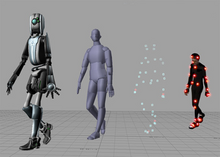
Back محاكاة الحشد Arabic Fodgængerdynamik Danish Gruppensimulation German Simulación de multitudes Spanish Simulation de foule French Crowd simulation Italian 群集シミュレーション Japanese සමූහ උත්තේජනය Singhalese Моделювання типу скупчення Ukrainian 人群模擬 ZH-YUE
| Three-dimensional (3D) computer graphics |
|---|
 |
| Fundamentals |
| Primary uses |
| Related topics |
Crowd simulation is the process of simulating the movement (or dynamics) of a large number of entities or characters.[1] It is commonly used to create virtual scenes for visual media like films and video games, and is also used in crisis training,[2] architecture and urban planning,[3] and evacuation simulation.[4]
Crowd simulation may focus on aspects that target different applications. For realistic and fast rendering of a crowd for visual media or virtual cinematography, reduction of the complexity of the 3D scene and image-based rendering are used,[5] while variations (changes) in appearance help present a realistic population.[6][7]
In games and applications intended to replicate real-life human crowd movement, like in evacuation simulations, simulated agents may need to navigate towards a goal, avoid collisions, and exhibit other human-like behavior. Many crowd steering algorithms have been developed to lead simulated crowds to their goals realistically. Some more general systems are researched that can support different kinds of agents (like cars and pedestrians),[8] different levels of abstraction (like individual and continuum),[9] agents interacting with smart objects,[10] and more complex physical and social dynamics.[11]
- ^ Thalmann, Daniel (2016). "Crowd Simulation". Encyclopedia of Computer Graphics and Games. pp. 1–8. doi:10.1007/978-3-319-08234-9_69-1. ISBN 978-3-319-08234-9.
- ^ http://cc.ist.psu.edu/BRIMS/archives/2007/papers/07-BRIMS-025.pdf Archived 2016-12-21 at the Wayback Machine Jérôme Comptdaer, Emmanuel Chiva, Stéphane Delorme, Henri Morlaye, Jérôme Volpoët, Multi-scale behavioral models for urban crisis training simulation.
- ^ Drettakis, George; Roussou, Maria; Reche, Alex; Tsingos, Nicolas (2007). "Design and Evaluation of a Real-World Virtual Environment for Architecture and Urban Planning" (PDF). Presence: Teleoperators and Virtual Environments. 16 (3): 318–32. doi:10.1162/pres.16.3.318. S2CID 15945042.
- ^ Gwynne, S.; Galea, E.R.; Owen, M.; Lawrence, P.J.; Filippidis, L. (1999). "A review of the methodologies used in the computer simulation of evacuation from the built environment". Building and Environment. 34 (6): 741–9. Bibcode:1999BuEnv..34..741G. doi:10.1016/S0360-1323(98)00057-2.
- ^ Tecchia, Franco; Loscos, Celine; Chrysanthou, Yiorgos (2002). "Visualizing Crowds in Real-Time". Computer Graphics Forum. 21 (4): 753–65. doi:10.1111/1467-8659.00633. S2CID 17920285.
- ^ Thalmann, Daniel; Grillon, Helena; Maim, Jonathan; Yersin, Barbara (2009). "Challenges in Crowd Simulation". 2009 International Conference on CyberWorlds. pp. 1–12. CiteSeerX 10.1.1.365.5045. doi:10.1109/CW.2009.23. ISBN 978-1-4244-4864-7. S2CID 12214496.
- ^ Maim, J.; Yersin, B.; Thalmann, D. (2009). "Unique Character Instances for Crowds". IEEE Computer Graphics and Applications. 29 (6): 82–90. doi:10.1109/MCG.2009.129. PMID 24806782. S2CID 13903301.
- ^ Chao, Qianwen; Deng, Zhigang; Jin, Xiaogang (2015). "Vehicle-pedestrian interaction for mixed traffic simulation". Computer Animation and Virtual Worlds. 26 (3–4): 405–12. doi:10.1002/cav.1654. S2CID 15616437.
- ^ Sewall, Jason; Wilkie, David; Lin, Ming C. (2011). "Interactive hybrid simulation of large-scale traffic". ACM Transactions on Graphics. 30 (6): 1. doi:10.1145/2070781.2024169.
- ^ Kallmann, Marcelo; Thalmann, Daniel (1999). "Modeling Objects for Interaction Tasks". Computer Animation and Simulation '98. Eurographics. pp. 73–86. CiteSeerX 10.1.1.550.2013. doi:10.1007/978-3-7091-6375-7_6. ISBN 978-3-211-83257-8.
- ^ http://dl.acm.org/citation.cfm?id=1272705 Pelechano, N. and Allbeck, J. M. and Badler, N. I. Controlling individual agents in high-density crowd simulation. In Proceedings of the 2007 ACM SIGGRAPH/Eurographics Symposium on Computer Animation. ISBN 978-1-59593-624-0